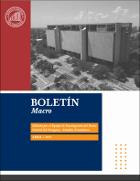| dc.creator | Bejarano, Willian |
| dc.creator | Biedermann, Gustavo |
| dc.creator | Legal, Diego |
| dc.creator | Ruíz Díaz, Victor |
| dc.creator | Ortiz Ibarrola, Guillermo |
| dc.date.accessioned | 2021-05-13T01:47:45Z |
| dc.date.available | 2021-05-13T01:47:45Z |
| dc.date.created | 2021-04-30 |
| dc.date.issued | 2021-04-01 |
| dc.identifier.citation | Alcidi C., and Gros D., 2019. Public debt and the risk premium: a dangerous doom loop. VOXEU, May 2019. |
| dc.identifier.citation | Auerbach A., and Gorodnichenko Y., 2009. Fiscal Multipliers in Recession and Expansion. NBER Working Paper No. 17447. |
| dc.identifier.citation | Bank for International Settlements, 2012. Fiscal policy, public debt and monetary policy in emerging market economies. BIS Papers No 67. |
| dc.identifier.citation | Bornhost F. et al., 2011. When and how to adjust beyond the business cycle? A guide to structural fiscal balances. IMF Technical Notes and Manuals. |
| dc.identifier.citation | Carrière-Swallow Yan, David A. and Leigh D., 2018. The Macroeconomic Effects of Fiscal Consolidation in Emerging Economies: Evidence from Latin America. IMF Working Paper. Western Hemisphere Department |
| dc.identifier.citation | Huidron, R., M. Kose, F. Ohnsorge, 2016. Under the cloud of cycles: linkages between fiscal multipliers and positions. VOXEU, August 2016. |
| dc.identifier.citation | Ilzetzki E., Mendoza E. and Végh C., 2009. How big (small?) are fiscal multipliers? IMF Working Paper. Research Department. |
| dc.identifier.citation | Philip R., and Janssen J., 2002. Indicators of fiscal impulse for New Zealand. Treasury Working Paper Series from New Zealand Treasury, No 02/30. |
| dc.identifier.citation | Spilimbergo A., Symansky S., and Schindler M., 2009. Fiscal multipliers. IMF Staff Position Note. |
| dc.identifier.citation | Schinasi G., and Lutz M., 1991. Fiscal Impulse. IMF Working Paper. European and Fiscal Affairs Departments. |
| dc.identifier.uri | https://repositorio.bcp.gov.py/handle/123456789/182 |
| dc.description | El presente trabajo permite evaluar cómo afecta la política fiscal a la dinámica cíclica de la economía y a la gestión de la política monetaria en un horizonte de corto y mediano plazo. Para ello, se utiliza un modelo semiestructural ampliado con un bloque fiscal, el cual permite realizar ejercicios de impulso-respuesta para cuantificar el impacto de la política fiscal en la demanda agregada, la inflación, las tasas de interés y el tipo de cambio. Igualmente, se realizan simulaciones de consolidación y expansión fiscal fijando una trayectoria exógena para el objetivo de endeudamiento. El modelo muestra que, en un escenario de convergencia fiscal, reduciendo la deuda pública y el déficit presupuestario, el impacto contractivo en el PIB y la brecha del producto es relativamente bajo, lo cual es bueno para la tasa de interés y el riesgo país. |
| dc.format.extent | 23 |
| dc.format.mimetype | application/pdf |
| dc.language.iso | spa |
| dc.publisher | Banco Central del Paraguay |
| dc.relation.ispartofseries | Boletines Macro |
| dc.relation.isversionof | Boletines Macro; N° 11 |
| dc.subject | PARAGUAY |
| dc.subject | POLITICA FISCAL |
| dc.title | La política fiscal a través de la óptica de un modelo semiestructural |
| dc.type | article |
| dc.subject.jelspa | E62 |
| dc.rights.accessRights | Open Access |
| dc.type.spa | Boletín Macroeconómico |
| dc.type.hasversion | Published Version |
| dc.rights.spa | Acceso abierto |

